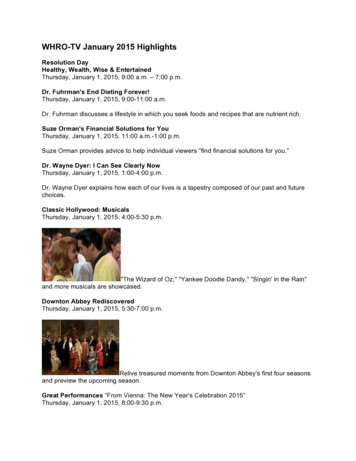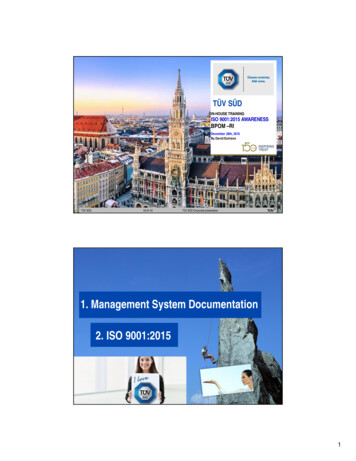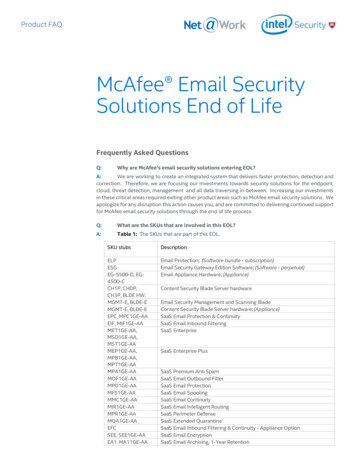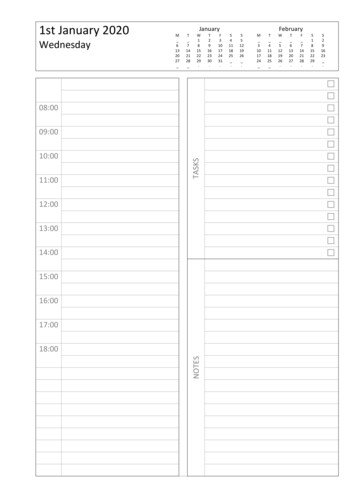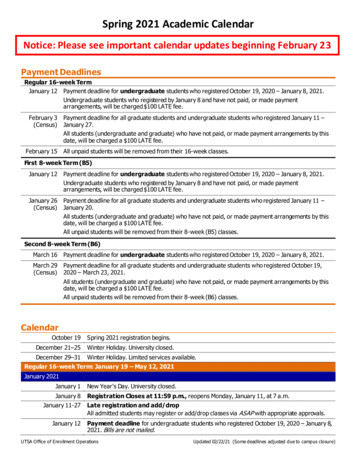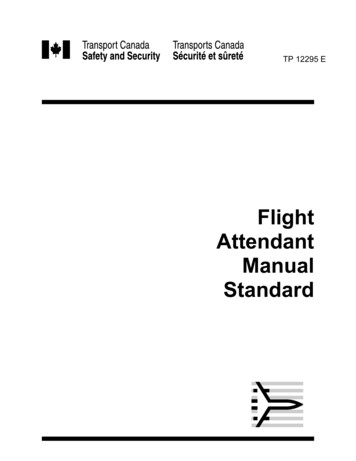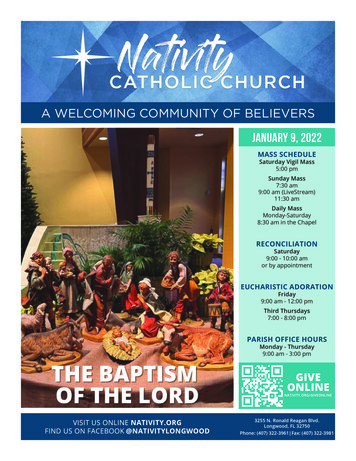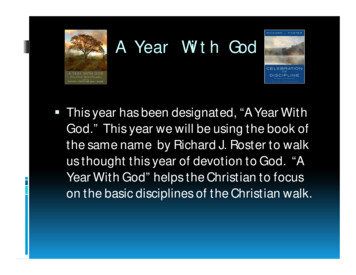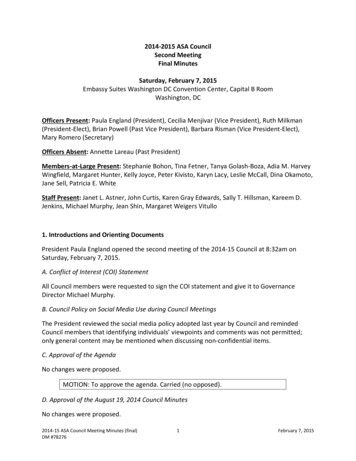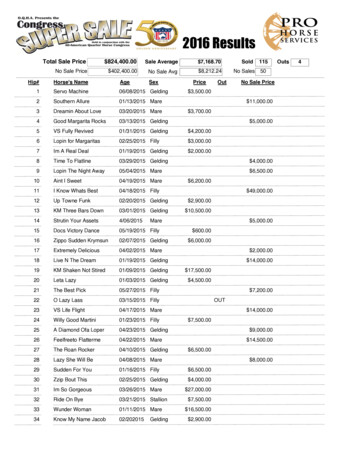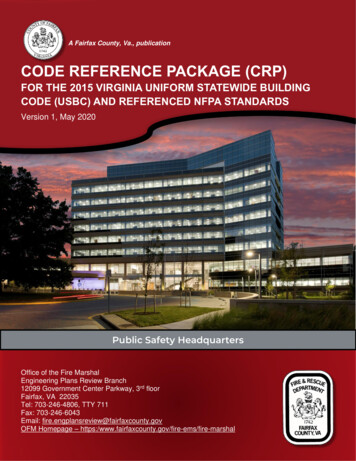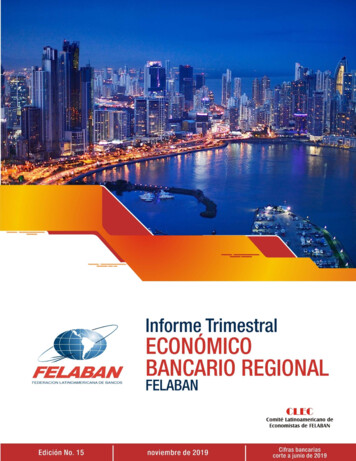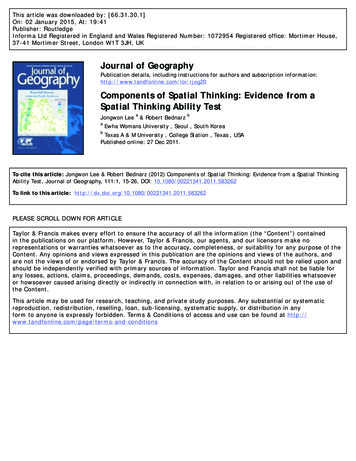
Transcription
This article was downloaded by: [66.31.30.1]On: 02 January 2015, At: 19:41Publisher: RoutledgeInforma Ltd Registered in England and Wales Registered Number: 1072954 Registered office: Mortimer House,37-41 Mortimer Street, London W1T 3JH, UKJournal of GeographyPublication details, including instructions for authors and subscription omponents of Spatial Thinking: Evidence from aSpatial Thinking Ability TestaJongwon Lee & Robert BednarzabEwha Womans University , Seoul , South KoreabTexas A & M University , College Station , Texas , USAPublished online: 27 Dec 2011.To cite this article: Jongwon Lee & Robert Bednarz (2012) Components of Spatial Thinking: Evidence from a Spatial ThinkingAbility Test, Journal of Geography, 111:1, 15-26, DOI: 10.1080/00221341.2011.583262To link to this article: SE SCROLL DOWN FOR ARTICLETaylor & Francis makes every effort to ensure the accuracy of all the information (the “Content”) containedin the publications on our platform. However, Taylor & Francis, our agents, and our licensors make norepresentations or warranties whatsoever as to the accuracy, completeness, or suitability for any purpose of theContent. Any opinions and views expressed in this publication are the opinions and views of the authors, andare not the views of or endorsed by Taylor & Francis. The accuracy of the Content should not be relied upon andshould be independently verified with primary sources of information. Taylor and Francis shall not be liable forany losses, actions, claims, proceedings, demands, costs, expenses, damages, and other liabilities whatsoeveror howsoever caused arising directly or indirectly in connection with, in relation to or arising out of the use ofthe Content.This article may be used for research, teaching, and private study purposes. Any substantial or systematicreproduction, redistribution, reselling, loan, sub-licensing, systematic supply, or distribution in anyform to anyone is expressly forbidden. Terms & Conditions of access and use can be found at ns
Components of Spatial Thinking: Evidence from a SpatialThinking Ability TestJongwon Lee and Robert BednarzDownloaded by [66.31.30.1] at 19:41 02 January 2015ABSTRACTThis article introduces the development andvalidation of the spatial thinking abilitytest (STAT). The STAT consists of sixteenmultiple-choice questions of eight types.The STAT was validated by administering itto a sample of 532 junior high, high school,and university students. Factor analysisusing principal components extraction wasapplied to identify underlying spatialthinking components and to evaluatethe construct validity of the STAT.Spatial components identified throughfactor analysis only partly coincided withspatial concepts used to develop thequestions that compose the STAT andwith the components of spatial thinkinghypothesized by other researchers.Key Words: spatial thinking, spatialthinking ability test (STAT), factor analysisDr. Jongwon Lee is an assistant professor ofsocial studies education (geography educationmajor) at Ewha Womans University, Seoul,South Korea. His research interests are in theareas of geography education: spatial cognitionand skills, especially the role of geospatialtechnology in spatial thinking.Robert Bednarz is professor of geography, TexasA & M University, College Station, Texas, USA,and North American Commissioning Editor ofthe Journal of Geography in Higher Education.His recent research has focused on spatial thinking, the impact of using geospatial technologieson spatial thinking skills, assessment of spatial thinking skills, and the implementation ofgeospatial technologies in science and geosciencecurricula.INTRODUCTIONSpatial thinking has been actively investigated during the last decade, especiallywith respect to its relationship to geospatial technologies and its relevanceto problem solving in everyday life, the workplace, and science (Albert andGolledge 1999; Battersby, Golledge, and Marsh 2006; Bednarz 2004; Golledge 2002;Marsh, Golledge, and Battersby 2007). However, long before researchers beganto focus on spatial thinking, psychologists and others sought to identify andmeasure spatial ability. Spatial ability—typically defined as spatial perception,visualization, and orientation—is seen as a narrower concept than spatial thinking(Committee on Support for Thinking Spatially 2006). It is beyond the scope ofthis article to provide a comprehensive review of the literature concerning thedifferences and distinctions between spatial ability, spatial reasoning, spatialcognition, spatial concepts, spatial intelligence, and environmental cognition.Learning to Think Spatially, published by the National Research Council, whilerecognizing that no clear consensus as yet exists concerning spatial thinking,provided a significant step toward understanding its nature and its importancein the school curriculum. The Committee (26) saw spatial ability as “a trait that aperson has and as a way of characterizing a person’s ability to perform mentallysuch operations as rotation, perspective change, and so forth. The conceptderives in part from the psychometric tradition of intelligence measurementand testing . . . ” The Committee viewed spatial thinking, on the other hand, as aconstructive amalgam of three mutually reinforcing components: the concept ofspace, tools of representation, and processes of reasoning. In order for individualsto conceptualize space, understand representations, and reason spatially, theymust possess the appropriate spatial skills (Committee on Support for ThinkingSpatially 2006).The Committee (2006) also recognized the educational value of spatial thinking,arguing that it can be taught and learned; thus spatial thinking should be animportant part of the educational curriculum at all levels. The Committee furthersuggested that GIS and other geospatial technologies can play a powerful role inpromoting spatial thinking. In fact, many studies have pointed to the advantageof integrating GIS into the classroom (e.g., Allen 2007; DeMers and Vincent 2007;Doering and Veletsianos 2007; Milson and Earle 2007; Patterson, Reeve, and Page2003) and have shown explicit links between GIS learning and students’ spatialthinking skills (Kerski 2008; Lee and Bednarz 2009; Schultz, Kerski, and Patterson2008).However, researchers have also argued that “to be most effective, GIS teachingand curriculum development strategies should begin with an assessment ofstudent understanding of spatial relationships. . . ” (Wigglesworth 2003, 282),emphasizing the importance of establishing viable spatial thinking assessmentbased on a scientifically rigorous definition (Eliot and Czarnolewski 2007).Unfortunately, such a standardized measure of essential knowledge and skillsdoes not exist. In fact, the Committee stated explicitly that “[t]here are neithercontent standards nor valid and reliable assessments for spatial thinking”(Committee on the Support for Thinking Spatially 2006, 232).This article begins with a brief discussion of concepts of spatial thinkingskills and the instruments available to measure them. Next, the article presentsthe development and validation procedures of the spatial thinking ability testJournal of Geography 111: 15–26 C 2012 National Council for Geographic Education15
Jongwon Lee and Robert Bednarz(STAT) that is modeled after the spatial skills test (Leeand Bednarz 2009). Data are presented that support thevalidity and reliability of STAT based upon a field testof 532 junior high, high school, and university students.The differences in the performance of these three levelsof students are explored and tested for significance usingANOVA. In addition, factor analysis is applied to identifyunderlying spatial thinking components, to determine ifthe identified components support the structure of spatialthinking proposed by other researchers, and to evaluate theconstruct validity of the STAT.Downloaded by [66.31.30.1] at 19:41 02 January 2015CONCEPTS OF SPATIAL THINKINGBecause the term “spatial thinking” has been used in bothnonacademic and academic areas extensively, a variety ofdefinitions exist (Committee on the Support for ThinkingSpatially 2006; Eliot and Czarnolewski 2007; Gersmehl 2005;Gersmehl and Gersmehl 2006; 2007; Golledge and Stimson1997; Harris 1981; Marsh, Golledge, and Battersby 2007;Montello et al. 1999). In addition, substantial disagreementcontinues to occur about the scale (from tabletop scaleto geographic scale) and dimensions (thinking in, about,and with space) of spatial thinking, about the nature ofcognitive processes involved, about the number of majorcomponents, and, as noted in the introduction, about therelationship, if any, between spatial ability and spatialthinking.A few studies provide valuable input for the development of spatial thinking assessments. These studies suggesta series of spatial thinking concepts and describe differencesbetween expert and novice performance in spatial thinking.Some of the most useful studies include Learning to ThinkSpatially (Committee on the Support for Thinking Spatially2006), Gersmehl’s (2005) spatial thinking taxonomy, andGolledge and others’ categorization of geospatial concepts(Battersby, Golledge, and Marsh 2006; Golledge 2002;Golledge and Stimson 1997; Golledge, Marsh, and Battersby2008; Marsh, Golledge, and Battersby 2007).Learning to Think Spatially (Committee on the Support forThinking Spatially 2006) introduces three spatial contexts:life space (cognition in space), physical space (cognitionabout space), and intellectual space (cognition with space).The first of these involves thinking about the world in whichwe live. It often includes way-finding and navigation inthe real, geographic world. It also includes other everydayactivities including assembling it furniture by followinginstructions, packing the trunk of a car to maximize carryingcapacity, etc. The second context, cognition about space,focuses on “a scientific understanding of nature, structure,and function of phenomena that range from the microscopicto the astronomical scales” (30). It is useful in explainingthe structure of the atom or DNA, the movement andarrangement of the elements of the solar system, etc.Other examples include “shapes and structures of urbanareas, the diffusion of cultures and agriculture, or the16organization of the world economy” (Bednarz n.d.). Theconcept or object investigated through the third context isnot necessarily spatial but can be spatialized by time-spacecoordination. For example, written linguistic symbols arespatially defined and spatially arranged, and readers mustestablish word order so that sentence and passage meaningcan be determined. Patterns in complex numerical data canoften be revealed and best understood by portraying theinformation graphically.Although Learning to Think Spatially (Committee on theSupport for Thinking Spatially 2006) provides multicontextual and interdisciplinary definitions of spatial thinking, ithas been criticized for its lack of a conceptual framework,an essential prerequisite for development of assessmenttools (e.g., Gersmehl and Gersmehl 2006). Previous researchis not devoid of conceptual frameworks, however, asGersmehl and Gersmehl (2006, 2007) and Golledge andothers (Battersby, Golledge, and Marsh 2006; Golledge1995, 2002; Golledge and Stimson 1997; Golledge, Marsh,and Battersby 2008; Marsh, Golledge, and Battersby 2007)have proposed hierarchies of spatial thinking skills andconcepts. In a study to specify a taxonomy of spatialthinking, Gersmehl and Gersmehl (2006, 2007) definedspatial thinking as skills that geographers use to analyze thespatial relationships in the world. They identified thirteenmodes of spatial thinking: defining a location, describingconditions (the geographic concept of site), tracing spatialconnections (situation), making a spatial comparison, inferring a spatial aura (influence), delimiting a region, fitting aplace into a spatial hierarchy, graphing a spatial transition,identifying a spatial analog, discerning spatial patterns,assessing a spatial association, designing and using a spatialmodel, and mapping spatial exceptions. They argued thatbrain research suggests that these modes of spatial thinkinghave distinct or independent neurological foundations.They offered no empirical evidence or other rigorousassessment to support their hypothesis that the modes theyidentified are independent, however.A hierarchical set of spatial thinking concepts was proposed by Golledge and his colleagues (2008). This sequenceprogresses from four basic spatial concepts (or primitives)to more complex and abstract concepts through five different levels as follows (Golledge, Marsh, and Battersby 2008,91–92): (1) primitive level (identity, location, magnitude,space-time); (2) simple level (arrangements, distribution,line, shape, boundary, distance, reference frame, sequence);(3) difficult level (adjacency, angle, classification, coordinate, grid pattern, polygon); (4) complicated level (buffer,connectivity, gradient, profile, representation, scale); and(5) complex level (area association, interpolations, mapprojection, subjective space, virtual reality). The spatialthinking skills suggested by the Gersmehls (2006, 2007)and geospatial concepts proposed by Golledge, Marsh,and Battersby (2008) share the common context of thegeographic scale. However, whereas Gersmehls’ conceptsare related to geographic analysis, the geospatial concepts
Components of Spatial Thinking: Evidence from a Spatial Thinking Ability TestTable 1. Core concepts of spatial thinking suggested by Gersmehl and Gersmehl (2007),Golledge, Marsh, and Battersby (2008), and Janelle and Goodchild (2009).Gersmehl andGersmehl (2007)Downloaded by [66.31.30.1] at 19:41 02 January 2015ConditionLocationConnectionGolledge et Pattern MatchingBufferAdjacency, ClassificationJanelle and Goodchild(2009)Objects and FieldsLocationNetworkDistanceScaleGolledge, Marsh, and Battersby(2008), and Janelle and Goodchild(2009) are summarized in Table 1.Although the terms and number ofcore concepts that they used aredifferent, it is not difficult to findsimilarity among them.MEASUREMENT OF SPATIALTHINKING ABILITIESA variety of psychometric tests(Clements et al. 1997; Dean andComparisonMorris 2003; Hall-Wallace andAuraMcAuliffe 2002) have been widelyRegionNeighborhood andused to measure individuals’ spaRegiontial abilities, especially in psychoHierarchylogical research. However, psychoTransitionGradient, ProfileAnalogymetric measures are limited to theCoordinateassessment of psychologically andPatternPattern, Arrangement, Distribution,narrowly defined spatial abilitiesOrder, Sequencerather than spatial thinking asSpatial AssociationSpatial Association,Spatial Dependence,defined by the Committee (2006)Overlay/Dissolve, InterpolationSpatial Heterogeneity(Hegarty et al. 2002; Lee and BedProjection, Transformationnarz 2009). Consistent with thisview, Eliot and Czarnolewski (2007,362) argued that “researchers needidentified by Golledge and his colleagues are intendedto go beyond the limits of existing spatial tests andprimarily to address the functions of GIS.consider the possibility that spatial intelligence is a moreThe present investigation, using experiments that beganencompassing construct of human activities . . . .”in 2006, could not benefit from the most recent workSelf-assessment questionnaires are believed to assessconcerning hierarchical geospatial ontology. However itbroader aspects of spatial thinking (Hegarty et al. 2002),did incorporate key spatial thinking concepts from severaland there are a few examples of these available on the Webstudies conducted by Golledge (1992, 1995, 2002). Along(e.g., Golledge 2000, 2001). A typical question from thesewith Gersmehls’ spatial thinking taxonomy, Golledge’s listinstruments might ask people to rate on a five- or sevenof geographic thinking elements presented in 2002 guidedpoint scale a statement such as, “When traveling, I takethe development of the spatial thinking ability test on whichshortcuts as frequently as possible.” Although researchersthis study is based. The following list from Golledge’s 2002have found that self-report measures are capable of assessstudy specifies the spatial thinking elements he thoughting spatial skills on both the small (or pictorial) and large (orwere important and illustrates the ideas and concepts hisenvironmental) scales (Hegarty et al. 2002) and are usefulwork shares with Gersmehls’ (2005):in assessing individuals’ spatial behaviors in everyday life,they are more appropriate for classifying types of spatialComprehending spatial association (posbehavior than determining levels of spatial ability. Anotheritive and negative); comprehending spashortcoming of subjective self-report measures is that oftential classification (regionalization); comthe results from different instruments are incomparable.prehending spatial change and spatialThere have been some important attempts to measurespread (spatial diffusion); comprehendingspecific aspects of spatial thinking skills (e.g., Albertnon-spatial and spatial hierarchy; comand Golledge 1999; Battersby, Golledge, and Marsh 2006;prehending spatial shapes and patterns;Gilmartin and Patton 1984; Golledge 1992; Kerski 2000;comprehending locations and places; comLloyd and Bunch 2003). For example, Golledge (1992) invesprehending integration of geographic featigated how completely people understand spatial conceptstures represented as points, networks, andsuch as “nearest neighbor” using a map-based laboratoryregions; comprehending spatial closure (inexperiment. Battersby, Golledge, and Marsh (2006) devisedterpolation); and recognizing spatial form.a task assessing individuals’ understanding and ability(Golledge 2002, 4–6)to apply one of the most essential GIS functions—mapoverlay. In that study, participants were provided two mapsThe core concepts of spatial thinking from three recent imof the same area and asked to derive conclusions aboutportant sources including Gersmehl and Gersmehl (2007),17
Downloaded by [66.31.30.1] at 19:41 02 January 2015Jongwon Lee and Robert Bednarzthe spatial relationships. In order to answer the questionsproperly, participants had to combine two thematic layersof information and perform logical functions (i.e., Booleanlogic). In a similar study, Albert and Golledge (1999) useda simplified set of thematic layers to evaluate how well GISusers could select appropriate map layers and operationsand visually verify map overlay processes to achieve aspecific result.Another type of spatial task used to assess individuals’spatial ability includes map-reading skills such as followingdirections, judging distances, comprehending geographiccharacteristics, and recognizing patterns (Carswell 1971;Gilmartin and Patton 1984). Map-reading skills devised byGilmartin and Patton (1984) provided students with representations of a country’s population distribution, topography, and climate that they then used to answer multiplechoice questions such as “Which of the country’s threemajor cities has the largest population?” Also includedin the same study was a road map-reading task to assessabilities such as distance estimation, route comparison (e.g.,visually compare two straight-line distances and judgewhich is shorter), and pattern recognition (e.g., choosewhich of four generalized diagrams best represents theoverall road pattern in the study area). Finally, Kerski(2000) created a task that assessed both the spatial concept,“best location,” and map reading simultaneously. He askedstudents to analyze geographic information and select thebest location for a fast food restaurant in a hypothetical areabased on a given set of variables including traffic volume,existing fast food locations, locations of high schools, andannual median income.DEVELOPMENT OF THE SPATIAL THINKING ABILITYTEST (STAT)One goal of the present study was to develop a standardized test of spatial thinking abilities (the spatial thinkingability test (STAT)) that integrates geography contentknowledge and spatial skills. Currently no standardizedinstrument for assessing the set of spatial thinking skillsdiscussed previously exists. In addition, the reviewedstudies using questionnaires or other measures to assessspatial skills often ignored issues of reliability and validity.The current study extends the authors’ research (Lee andBednarz 2009) that developed and deployed spatial skillstests (SST) to measure changes in students’ spatial skillsafter they completed GIS coursework. That research founda significant relationship between the completion of one ormore geospatial technology courses and students’ scores onthe spatial skills test. The components of spatial relationsas defined by Golledge and Stimson (1997) provided guidelines for developing test items. The spatial skills tests consistof a set of multiple-choice questions and performance tasksthat were designed to evaluate students’ skills includingoverlaying and dissolving a map, reading a topographicmap, evaluating several factors to find the best location,recognizing spatially correlated phenomena, constructing18isolines based on point data, and differentiating amongspatial data types.The initial motivation to revise and augment the originalspatial skills test was to measure students’ mastery of thecontent and skills contained in the Association of AmericanGeographers’ Teachers’ Guide to Modern Geography (TGMG)project materials. The primary aim of the TGMG, fundedby the U.S. Department of Education, is to improve thepreparation and ability of geography teachers to incorporate spatial thinking skills into their classes. The TGMGproject produced a variety of print and digital materialsfor preservice and in-service teacher preparation programs,for example, a multimedia CD with animated instructionalunits that deal with the analytical skills specified in theNational Geography Standards, such as measuring direction,distance, slope, and density; analyzing map patterns andmaking rigorous map comparisons; formulating and testinghypotheses; identifying exceptions to patterns predictedby hypotheses; and buffering, overlaying, windowing, andother methods of spatial analysis. The spatial thinkingability test (STAT) was designed to assess individuals’growth in spatial thinking skills and to help determinethe effectiveness of the TGMG materials in promotingthe spatial thinking skills of teachers. The revised andexpanded spatial skills test also provided a data set thatcan be used to provide a preliminary assessment of thereliability and validity of the previously noted spatialthinking conceptualizations proposed by other researchers.The initial step in the construction of the STAT was thedelineation of the assessment objective and the descriptionof the test contents to be measured. Two sets of spatialthinking concepts were analyzed and combined and servedto inform the development of STAT. The first set of conceptswas identified by Gersmehl (2005) whose ideas served asthe theoretical foundation of the TGMG project. The secondset was comprised of Golledge’s (2002) list of spatial thinking skills, which played a key role in the development ofthe original spatial thinking ability test. Golledge’s conceptswere especially useful because they were detailed enoughto develop test items, potentially leading to improvementof test content validity. Additionally, both lists share somecommon concepts and features as noted previously.Each test item was designed to measure one or twocomponents of spatial thinking identified by one or both ofthese two studies. The aspects of spatial thinking abilitiescovered by STAT include: (1) comprehending orientationand direction; (2) comparing map information to graphicinformation; (3) choosing the best location based on severalspatial factors; (4) imagining a slope profile based ona topographic map; (5) correlating spatially distributedphenomena; (6) mentally visualizing 3-D images basedon 2-D information; (7) overlaying and dissolving maps;and (8) comprehending geographic features represented aspoint, line, or polygon (see Table 2).During the development of STAT, we focused on acentral problem related to test construction: how toensure practicability while at the same time providing
Components of Spatial Thinking: Evidence from a Spatial Thinking Ability TestTable 2. Description of question types and spatial thinking components to measure.Downloaded by [66.31.30.1] at 19:41 02 January 2015Type(Item Number)ItemDescriptionI (#1, #2)In order to solve item #1 and #2,participants should visuallynavigate road maps usingverbal information includingparticipant’s current location,directions to destination, streetinformation, etc. (See Fig. 1)II (#3)In order to solve item #3,participants should recognizemap patterns and representthem in graphic form.III (#4)In order to solve item #4,participants should select anideal location for a fictitiousfacility based on multiple piecesof spatial information such asland use, elevation, populationdensity, etc.In order to solve item #5,participants should create aprofile of topography along aproposed line on a contour map.In addition, the participantsneed to properly orientthemselves in situ.IV (#5)V (#6, #7)In order to solve item #6,participants should identifyspatial correlations betweensets of maps. Additionally, item#7 asks participants to displaythe identified spatial relationshipin a graphic form. (See Fig. 1)VI (#8)In order to solve item #8,participants need to mentallyvisualize a 3-D image based on2-D information. (See Fig. 1)VII (#9, #10,#11, #12)In order to solve item #9, #10, #11,and #12, participants shouldvisually verify a map overlayprocess and then select theappropriate map layers involvedin the overlay. (See Fig. 1)Spatial ThinkingComponents to MeasureItem #1 and #2 evaluate the traitof “comprehending orientationand direction (e.g.,forward-backward; left-right;up-down; st)”(Golledge 2002).Item #3 assesses the trait of“discerning spatial patterns”(Gersmehl 2005) and “graphinga spatial transition” (Gersmehl2005).The basic rationale behind item #4is to assess the trait“comprehending overlay anddissolve” (Golledge 2002) and“inferring a spatial aura(influence)” (Gersmehl 2005).In solving item #5, participantsdeal with several cognitive traitsincluding “recognizing spatialform (such as cross-sections tothree-dimensional blockdiagrams or image)” (Golledge2002), “being able to transformperceptions, representationsand images from one dimensionto another and the reverse”(Golledge 2002) and “graphinga spatial transition” (Gersmehl2005).Item #6 and #7 evaluate the trait“comprehending spatialassociation (positive andnegative)” (Golledge 2002),“making a spatial comparison”(Gersmehl 2005), and“assessing a spatialassociation” (Gersmehl 2005).Item #7 additionally assessesthe trait of “graphing a spatialtransition” (Gersmehl 2005).Item #8 assesses the trait of“being able to transformperceptions, representationsand images from one dimensionto another and the reverse”(Golledge 2002).Item #9, #10, #11, and #12correspond to the trait“overlaying and dissolvingmaps” (Golledge 2002).(Continued on next page)maximum comprehensibility ofspatial thinking concepts. A number of other factors were alsoconsidered in the design of theSTAT. These factors included (1)cognitive process (i.e., maximizingspatial processes and minimizingverbal processes); (2) psychometricrationale; (3) mode of representation (text, picture, graph, map,color versus black and white, etc.);and (4) practical constraints (e.g.,amount of time required to complete the test).The current version of the testis fourteen pages long and hastwo equivalent forms (one thatcan be used for a pretest andone for a post-test) allowing forthe evaluation of changes in spatial thinking skills over a periodof time. The pre- and post-testswere composed of slightly differentquestions covering the same spatialthinking skills. Each form, containing sixteen multiple-choice questions, consists of eight differenttypes of questions (Table 2). Figure1a and 1b contain a sample of itemsfrom the STAT. We also constructeda three-item questionnaire to collect information about the subject’sgender, academic major (geography major or not), and amount ofgeospatial coursework completed(e.g., GIS and cartography).Formal and informal reviewof STAT took place in a variety of venues, mostly conductedas part of the evaluation planof the TGMG project. After adraft of STAT was completed, allitems were carefully reviewed bya team of experts consisting primarily of the TGMG project teamand steering committee members.The team included two individuals who teach geographic education courses for undergraduateand graduate students; these members conducted an informal reviewand then pilot-tested the instrument with their students. Twentyseven undergraduate students participated in a pilot test that helpedestimate the difficulty level ofSTAT and reduce the incidenceof errors in test administration.19
Jongwon Lee and Robert BednarzTable 2. Description of question types and spatial thinking components to measure.(Continued)Type(Item Number)In order to solve item #13, #14,#15, and #16, participantsshould visually extract types ofspatial data from verballyexpressed spatial information.(See Fig. 1)Spatial ThinkingComponents to MeasureItem #13, #14, #15, and #16measure the trait“comprehending integration ofgeographic featuresrepresented as points,networks, and regions”(Golledge 2002) and“comprehending spatial shapesand patterns” (Golledge 2002).Downloaded by [66.31.30.1] at 19:41 02 January 2015VIII (#13, #14,#15, #16)ItemDescriptionRevisions were made as a c
Learning to Think Spatially, published by the National Research Council, while recognizing that no clear consensus as yet exists concerning spatial thinking, provided a significant step toward understanding its nature and its importance in the school curriculum.
